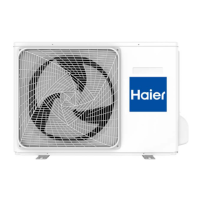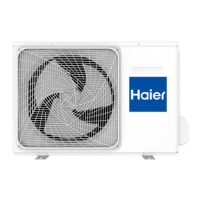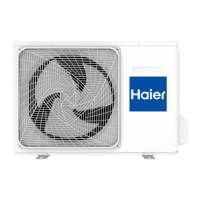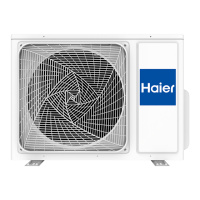1) Fixation
The support of the outdoor unit shall be fixed onto the wall surface, and then the outdoor unit shall be fixed onto
the support horizontally. In case the outdoor unit is wall-mounted or roof-mounted, the support shall be firmly
fixed, to avoid the damage of strong wind.
2)
Installation of
connecting pipes
The cone of the connecting pipes shall be aligned with the conical surface of corresponding valve connector.
The nut of connecting pipes shall be installed at a proper position and then be tightened with a spanner. Excessive
tightening torque shall be avoided, or otherwise the nut may be damaged.
•
Vacuumizing
A di
gital vacuum gauge shall be connected for vacuumizing. The duration of vacuumizing shall be at least 15
minutes, and the pressure of the vacuum gauge shall be below 60Pa.Afterwards, the vacuumizing equipment shall
be closed, and whether the reading of the digital vacuum gauge is increased or not shall be observed after the
pressure is maintained for 5 minutes. In case no leakage is identified, the two-way stop valve and three-way stop
valve of the outdoor unit may be opened. Finally, the vacuumizing hose connected to the outdoor unit can be
disassembled.
• Leak Detection
The joint of connecting pipes for the outdoor unit shall be subject to leak detection with soap bubble or
dedicated leak detection equipment.
• Post-installation Inspection Items and Test Run
Post-installation Inspection Items
Items to Be Checked Consequence of Improper Installation
Whether the installation is firm or not The unit may fall, vibrate or make a noise
Whether the inspection on air leakage is completed The refrigerating capacity (heating capacity) may be
insufficient
Whether the unit is fully insulated Condensation or drip may occur
Whether the drainage is smooth or not Condensation or drip may occur
Whether the power voltage is identical to that
marked on the nameplate
Failure may occur or the parts may be burned
Whether the circuit and pipeline are installed
correctly
Failure may occur or the parts may be burned
Whether the unit is safely earthed Electric leakage may occur
Whether the type of wire is in line with relevant
regulations
Failure may occur or the parts may be burned
Whether barriers are identified at the air inlet/outlet
of the indoor/outdoor unit
The refrigerating capacity (heating capacity) may be
insufficient
Whether the length of refrigerant pipes and the
refrigerant amount charged are recorded
The refrigerant amount charged cannot be confirmed
Test Run
1. Preparations
(1) Power on is not allowed before all the installation operations are completed and before the leak
detection is proven qualified.
(2) The control circuit shall be connected correctly and all the wires shall be firmly connected.
(3) The two-way stop valve and three-way stop valve shall be opened.
(4) All the scattered articles (especially the metal filing and thread residue) shall be removed from the unit
body.
2. Methods
(1) Switch on the power supply and press the “ON/OFF” on the remote controller, after which the air
conditioner will start operating.
(2) Press “Mode” to select refrigeration, heating and sweeping wind, and observe whether the air
conditioner is under normal operation.
6

